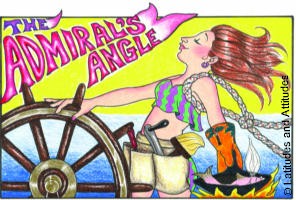 Admiral’s
Angle #3 – Getting Started Admiral’s
Angle #3 – Getting Started
“When I hear men lament that they have
a hard time getting their sweethearts to go cruising with them,”
writes one of my Admirals, Mary Verlaque of Iwanda,, “I ask what
their first sail was like. Rather than an easy sail into a quiet
anchorage where they watched the sun set while sharing an intimate
glass of wine, the story usually involves white knuckles, wet hair
and a feeling of total vulnerability for his would be crewmate.”
For adventurous ladies with cast-iron stomachs and nerves of steel,
this approach might work, but for reluctant crew, this is a helluva
start. I once read an entertaining cruising autobiography called If
the Shoe Fits: The Adventures of a Reluctant Boatfrau by Rae Ellen
Lee. Actually, it was less a cruising autobiography than a “getting
started” autobiography. Shoe was the boat her husband bought for
them in Port Townsend after a nice vacation in the Virgin Islands.
Coming from the mountains of Montana, they both had to learn how to
sail and live aboard. For some reason they started in winter. Her
husband Tom was the motivated learner, and as he taught himself,
with more than a few of those white-knuckled moments, he dragged her
along with him like a dinghy in a choppy sea.
There are easier ways. Mary and her husband Christian, for example,
started sailing lessons together in their 30s. They started with the
basics on small sailing dinghies, and gradually progressed to bigger
and bigger boats. One of the neat things about sailing is the
fundamental principles are the same whether you are in a dinghy or
the 40’ Camper Nicholson the Verlaques now sail in the Med. It’s the
forces that change, and, if you don’t plunge into the big forces
right away, you have time to internalize those fundamentals.
Although Mary and Christian started learning to sail at the same
time, the school’s policy separated couples. This allowed them to
“make mistakes and ask what may have been dumb questions without
involving each other as a couple.” Many women opt for women-only
sailing programs as offered all around the country. Under the
impression she was providing moral support for a friend, Mary went
along on a one-week women-only course and realized, in the
all-female milieu, how many onboard tasks she’d been avoiding:
engine and battery checks, sail selection, navigation, anchoring and
docking. “I came home enthusiastic about sailing and living aboard.
I felt empowered by the revelation that I could handle all those
necessary tasks. I kept telling Christian, ‘WE CAN DO THIS!’ ”
Of course, many cruisers were active sailors before they became
cruisers. Ellen Sanpere of Cayenne III, says she has always sailed.
“As an adolescent, I discovered I could go sailing if I hung around
the yacht club and offered to crew for the racing boats,” (a
strategy that would work for single gals of any age!) Ellen returned
to racing after a job transfer took her to Annapolis. She met her
husband Tony on the racing circuit there, and the pair seems to have
stumbled into full-time cruising simply by chasing down far-flung
races. Kathy Blanding and her husband Dave, currently prepping to
sail westward from Fiji, also started as small-boat racers. “Thanks
to the racing, I knew the names of the lines and the sails, how to
tack and gybe, and how to read the sails and trim accordingly. All
of that helped with my self-confidence when we moved up to our
Norseman 440 Sunflower.”
More commonly, couples get started like Mary Heckrotte of Camryka.
”My first date with Carl when I was 33 was to go sailing on his 26’
Westerly, my first ever sail. After that we rattled around Pamlico
Sound for years together on weekends and vacation days. Somewhere
along the way we met real people who actually lived aboard and poked
about the world. Such a wild idea!” Wild or not, the idea grew, Mary
and Carl upgraded to a 36’ Westerly, and they have been sailing the
Caribbean since 1992.
If you are starting from scratch with no history and no boat in the
back yard, I can’t imagine a better way to discover cruising than to
take a crewed charter. In the hands of professionals, novices can
concentrate on the pleasures of cruising – those romantic sundowners
-- without being plunged headlong into the responsibilities of a
bareboat. You can often pick your yacht by type, and many crews will
teach you as much as you want to learn. If you’re lucky, you’ll come
home itching to do it on your own!
|
 Admiral’s
Angle #3 – Getting Started
Admiral’s
Angle #3 – Getting Started

